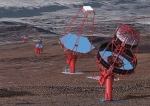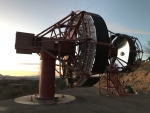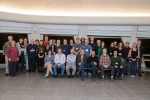Graduate student Leslie Taylor helped fine-tune a high-energy gamma-ray telescope this summer. Detecting the Crab Nebula was the "gold standard" for success.
A new telescope, part of an international effort to develop and build the world’s largest, most sensitive gamma-ray detector, was unveiled to the public Thursday (Jan. 17, 2019) in a ceremony at the Whipple Observatory on Arizona’s Mount Hopkins.
For the first time, an international collaboration of scientists has detected extremely high-energy gamma rays, the most powerful type of light, coming from the outermost regions of an unusual star system within our own galaxy. The source is microquasar SS 433, a black hole that gobbles up stuff from a nearby companion star and blasts out powerful jets of material. The team’s observations, described in the October 4 issue of the journal Nature, represent the most energetic radiation ever detected from a microquasar in our galaxy.
A unique high-speed camera, designed to capture the fleeting effects of gamma rays crashing into the Earth’s atmosphere, will soon be on its way from the University of Wisconsin–Madison to Arizona’s Mount Hopkins.
The American Physical Society meeting on astronomy, astrophysics, cosmology and particle physics, the so-called April meeting, closes today in Washington DC. The IceCube Collaboration has presented brand new results on neutrino oscillations that are comparable in precision to long-baseline neutrino experiments. From WIPAC, many PhD students and more senior staff presented results about IceCube, including the masterclass, along with results on CTA and Fermi.
Those of us working with high-energy neutrinos always have great expectations for a new year, since the highest energy neutrino ever could show up or a joint detection of a neutrino and another cosmic messenger might point us to the much sought-after sources.







